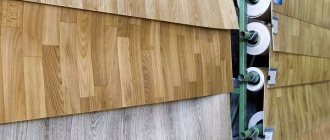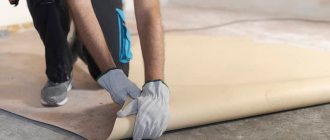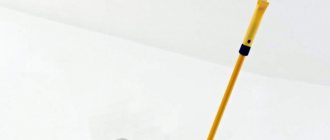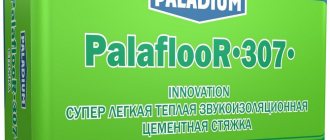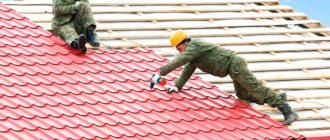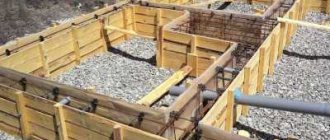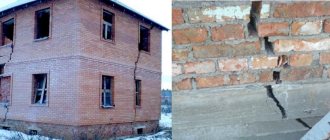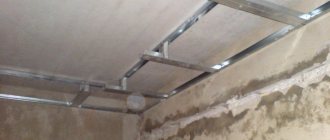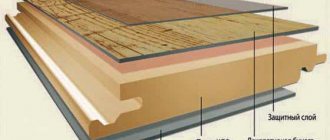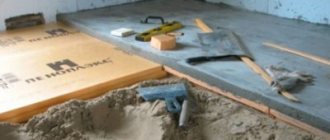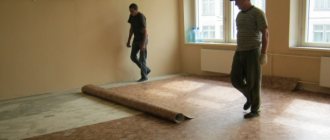Subfloor requirements
The parameters of the initial coating will subsequently directly affect the operation of the decorative surface. Therefore, it is necessary to carry out preliminary preparation work.
The main condition is a flat plane. Its strength and hardness are also important. Do I need to level the floor under linoleum for a concrete screed? Yes, if the level difference exceeds 5-8 mm per 1 m². The material used to make the decorative coating is quite elastic. This entails pros and cons. Under mechanical influence, linoleum will repeat the shape of the subfloor. If it is not leveled before installation, cracks, folds will appear on the decor, and more significant damage is possible.
But knowing how to level the floor under linoleum, it is necessary to fulfill other preparation conditions:
- Humidity level. Installation on fresh concrete screed is not recommended. It will continue to release water for some time, which will lead to the formation of condensation. The same applies to wooden bases. The humidity level should not exceed 5%;
- No dirt or dust. Even small debris can cause damage to expensive laminate flooring. Therefore, before laying it is necessary to vacuum the floor;
- Temperature conditions in the room. It should be from +15°C to +25°. At the same time, for better drying of the adhesive base, it is necessary to ensure a normal level of ventilation.
These are basic requirements that are suitable for any class of linoleum. But they can be supplemented by other installation conditions. It all depends on the manufacturer’s recommendations and the characteristics of a particular room. If you are not sure about the correctness of the chosen installation technology, you need to consult the seller or go to the manufacturer’s website.
Advice
It is important to choose the right type of substrate for linoleum. It is necessary if the base of the coating cannot provide operating conditions - waterproofness, thermal insulation.
Thus, household linoleum, which has a jute, fabric or PVC base, performs the function of insulation, which does not need a backing. We also note that linoleum, which has a base, will last you twice as long as its counterpart without a base. This warm look is half a centimeter thick, while remaining elastic.
In order to categorically say whether a substrate is needed for linoleum, it is necessary to accurately determine the characteristics of the base of the floor, which is intended for flooring. Thus, the basis for such a coating should have the following indicators:
- strength,
- high degree of hardness,
- absolute dryness,
- be level horizontally with minor differences in height,
- there should be no grease or oil stains on it, and there should be no traces of old paint.
Let's move on to consider possible reasons.
Electric heated floors under linoleum: types, disadvantages and advantages
When deciding which heated floor to buy for linoleum, most people prefer electric types. Their main advantage is ease of installation and operation. In addition, they can be installed in high-rise apartments.
The type of difference in electric heated floors depends on the type of heating elements. They are divided into cable, matte and film. Cable underfloor heating has the form of a heating cable, which is laid in a floor screed or placed in the form of heating mats covered with a heat-resistant film with a cable in the middle.
For heating, single-core and two-core cables are used. Laying a single-core cable involves returning the second end to the same point where the first is located. A two-core cable does not require this. In addition, it is more environmentally friendly: the radiation from it is 5 times less.
Electric heated floors are the best option for multi-storey apartments
There are cables with self-regulation, which protects the floor from overheating, but they cost several times more than simple ones. The price of cable underfloor heating is also affected by the specific power coefficient per 1 m² of room.
The basis for heating in film heated floors under linoleum is a thin film equipped with soldered graphite plates and copper conductors that pass current. The advantage of such a system is ease of installation. It can be laid under laminate, linoleum and in walls.
Infrared flooring under linoleum is the most economical; it does not require screeds. With a guaranteed service life of 15 years, it can last 50 years. In addition, film floors are cheaper than cable floors. Thus, this type of flooring is the most beneficial for DIY installation.
Heating elements in electric floors are film, cable and matte
Do-it-yourself installation of film heated floors under linoleum
Film heated floors are produced in special packages that contain a roll of thermal film, wiring, bitumen insulation and contact clamps. The number of packages required for purchase depends on the square footage of the room. In addition, to install the floor you will need thermostats, heat reflectors, protective polyethylene film, double-sided tape, and tools.
Preparatory work for installing a heated floor under linoleum, as in the case of simple laying of the canvas, includes leveling and cleaning the base, as well as marking and cutting the film. On a flat base floor, determine where the film will be laid out and measure the length of the sheets. The installation location of the thermostat is determined in advance. Next, cut the thermal film in special places marked with a dotted line.
Important! When marking, you should take into account the manufacturer’s requirement prohibiting the installation of thermal film under heavy furniture and objects.
The package with warm film floor contains thermal film, insulation, wiring and contact clamps
For the purpose of thermal insulation, an Izolon heat reflector is laid on the concrete floor. The canvases are attached to the base with tape. In the same way, parts of the heat-reflecting material are glued together, ensuring their reliable fixation. It is important to cover the entire floor with a heat reflector to prevent heat loss. Next, pre-cut pieces of thermal film are laid, and the copper strip must be located at the bottom.
The cuts in the copper busbar are covered with bitumen insulation in such a way as to reliably cover all the silver contacts that are responsible for connecting the copper busbar to the carbon strips. Then, at the place where the electrical wire is connected, contact clamps are mounted on the copper bus so that one end goes into the middle of the thermal film, and the other remains outside. The contact clamp is tightly secured. The film strips are fixed with tape on the heat reflector, as well as with each other.
Concrete base
Most often, a concrete screed is used as a subfloor. It can be found both in private houses and in apartment buildings. But the coating parameters are not always suitable for further installation of soft decor.
All methods of leveling a concrete floor come down to the formation of a flat plane on which linoleum will later be installed. If the level of differences is small, you can limit yourself to filling cracks and potholes. However, for checking you should use special tools - a building level and a rule. With their help you can see the actual curvature of the floor.
After the analysis, you can begin to choose a method for processing the concrete screed, which directly depends on the degree of unevenness. Currently there are several ways to get rid of this defect.
A concrete base is preferred over linoleum when leveled with a leveling compound.
On a note
An important point is that before laying the canvas on concrete, it must be allowed to dry.
The concrete will dry depending on the temperature in the room, as well as humidity and the degree of ventilation. As the norms say, the drying period can be up to thirty days.
Advice
It's easy to test for moisture in a screed: use a regular piece of cellophane. Place it on the screed overnight and secure it with tape. The next morning, look at the result: when the film remains dry, the finishing installation can begin. Before starting work, thoroughly clean the base from dust and dirt.
Another feature is that the concrete surface should never be leveled by covering it with plywood or other wooden material. Such materials will absorb moisture and, as a result, become deformed - therefore, on such a coating, linoleum will soon lose its operational advantages.
New screed
It is applied to the subfloor. If the level of heat loss is high enough, a heat-insulating layer of polystyrene foam or basalt wool is pre-installed. A leveling screed is poured over these materials.
First, the level of the future screed is determined. If the solution contains only cement and sand, then the minimum level can be from 5 cm. The use of plasticizers can reduce this figure to 3 cm. How to level the floors in an apartment under linoleum if the height difference is more than 20 cm? To do this, you need to pour two or more layers.
Work order.
- Installation of beacons. With their help, the height of the concrete screed is determined.
- Pouring the solution. It is important that there are a minimum of air bubbles in it.
- Leveling the surface.
Leveling mixture
If the level of difference in the subfloor is not strong, you can use special construction compounds. They are similar to the concrete mixtures described above. The difference lies in the method of application.
When the level difference is up to 20 mm, self-leveling mixtures are poured. They have a high level of fluidity and plasticity. To prepare the solution, you must read the instructions from the manufacturer. Before doing this, you need to know the material consumption. It is influenced by the area of the room and the height of the fill.
General instructions for using the leveling mixture.
- Cleaning the surface from dirt and dust.
- Mandatory filling of cracks and deep recesses. They will not only increase the consumption of the mixture, but will also affect the quality of the coating.
- Preparation of the solution. It must be mixed with water in strict proportions. The thicker the composition, the higher the maximum leveling height.
- Apply the solution to the prepared surface and level it using a special spiked roller. This way you can get rid of air bubbles inside.
The final drying time depends on the pouring height and the composition of the mixture. If cracks appear on the surface, they must be filled with putty.
Advice
You can professionally and quickly level a linoleum floor using epoxy-based compounds. They have the highest density - about 1.5 kg/l. This will affect the mechanical strength of the coating.
Preparing the base for the screed
The base for the screed must be perfectly clean, hard and durable.
We remove all unnecessary things from the room, remove old coverings and remove the old, destroyed screed.
We examine the slab for the presence of defects, delaminations, cracks.
Foundation repair
We repair cracks and seams between the slabs.
We remove dust using industrial vacuum cleaners with water filters that retain small particles.
We repair irregularities, damage and cracks with repair compounds or screed mortar.
It is better to seal the seams between the slabs with mortar using reinforcing mesh.
Important! I recommend treating the repaired and cleaned base with penetrating primers for better adhesion of the screed to the base.
Screed level marking
Using a laser or hydraulic level, mark a horizontal line at a level of 0.5-1 meters from the floor. This will be level zero.
From this line we take measurements to the floor and determine the highest point of the base.
Subtracting the thickness of the screed, about three centimeters, we mark the mark for the top of the screed. We transfer the top line of the screed to the wall, along the perimeter of the room, using a tapping cord.
Figure 2. Waterproofing the base under a polyethylene screed.
Base waterproofing
To prevent moisture from entering the reinforced concrete floors and to prevent flooding of the underlying premises, we waterproof the base.
Usually used:
- plastic film with a thickness of at least 100 microns;
- roofing felt;
- roofing membrane.
It is better to seal the passages through the ceilings of pipes and risers with silicone sealants.
We carry out waterproofing by going onto the walls 5-10 centimeters above the level of the screed.
We lay the strips of roofing felt overlapping and fasten them with construction tape.
We lay the membrane or film in one piece.
Apply liquid bitumen mastic evenly to the surface of the slab and along the entire perimeter of the wall to a height of 10 - 15 centimeters
Important! Attach damper tape around the perimeter of the room.
You can take a ready-made one or cut it out of foamed polyethylene. It should be three to five centimeters wider than the thickness of the screed.
Wooden floor
A wooden base is also acceptable for linoleum. However, wood is the most difficult surface to prepare. Its quality does not always meet even the most minimal requirements. During operation, boards change their configuration under the influence of temperature and humidity, and fungus or mold may form on their surface.
The first stage of work should be to check the condition of the surface. To do this, remove the old coating, as well as the paint layer, if present. Then the quality of the boards is analyzed - the absence of fungus, mold, compliance with the initial geometry. If necessary, individual floor elements are replaced.
When a wood covering has all sorts of unevenness, cracks, flaws and cracks from nails, it requires preliminary installation with plywood. In this case, plywood will be the basis for the main coating.
On a note
It should be noted that the plywood used to level the floor should be about 12 mm thick.
If the boards on the floor are well preserved, you don’t have to use additional plywood. Minor imperfections and cracks can be easily eliminated using putty.
The optimal methods for leveling a wooden floor directly depend on the verification results. If the surface condition is acceptable for installing decorative material, you can eliminate the installation of additional layers in the form of fiberboard, chipboard or plywood. Otherwise, the flooring must be made from these materials.
Looping
The essence of this method is to remove irregularities mechanically. To do this, use a plane or a special power tool. In the first case, scraping is chosen for floors with a small area or minor defects. Its disadvantage is labor intensity and possibly low quality of work.
For high-quality processing before laying linoleum on a wooden floor, it is best to use a scraper. This tool removes uneven surfaces using a tape or drum that has an abrasive surface. The advantage is the ability to quickly process a large area. Disadvantages include the high cost of purchasing or renting equipment.
Features of choice
When choosing a primer for linoleum, you should also take into account the base material. To avoid mistakes, you should study the composition and manufacturer’s recommendations when purchasing.
Primers for concrete floors
The use of a protective suspension on a concrete floor can reduce the absorbent properties of the material. This is achieved by filling small pores and cracks. This function is best accomplished by deep penetration soils: polyurethane, latex-based, Concrete Contact with mineral additives.
Primer for polymer screeds
The use of primer allows you to achieve a perfectly flat surface of the base. This helps in the future to lay linoleum without much difficulty.
To process polymer screeds, it is necessary to use Betonkontakt, epoxy and polyurethane compounds.
For cement-sand bases
This type of base is characterized by increased porosity and moisture absorption. To avoid the development of fungus and mold, after laying linoleum, it should be treated with an acrylic primer. This protective mixture is distinguished by its strengthening composition and deep penetration into the structure of the material.
For plywood
In this case, deep penetration soils should be used. The protective layer helps reduce the level of moisture absorption, prevent the formation of fungus and mold, increase the service life and prevent the destruction of the material.
For plywood, acrylic, alkyd, polystyrene, and glyphthalic primers should be used.
Old linoleum flooring
This becomes possible when the old material is firmly attached to the floor and has no unevenness, torn areas, or deformations. Then you can safely lay a new covering on it. Immediately before flooring, it is necessary to apply glue to the old surface and degrease it. If the expired coating does not meet the presented requirements, then it is unsuitable for the role of a substrate.
What should be the base for laying linoleum
The service life of the floor covering depends on the quality of the preparatory work, so this stage is very important, and in no case should it be neglected.
Leveling the base
Due to the fact that roll coverings are very elastic, the surface for laying linoleum must be perfectly flat. The slightest irregularities and bumps will lead to rapid wear of the coating, and it will very quickly lose its original appearance. And although this is quite difficult to achieve, knowing the basic rules, you can do it yourself.
Before you begin the flooring installation process, you need to make the floor as level as possible. The surface is carefully checked using a rule or a rod, the length of which must be at least two meters.
Before you begin the process of laying the material, make sure that the surface is not only fairly level, but also completely dry. Otherwise, the floor covering will not be able to adhere to the floor as it should.
Uneven floors can and should be straightened; this is done in several ways. The most popular is that some areas on the floor must be filled with a special screed on cement or any other base, or filled with a leveling mixture specially designed for this purpose. Currently, it is quite easy to purchase it at any hardware store.
Installation of additional covering
Often the quality of the floor is so poor that its treatment cannot give the desired results. Therefore, an alternative option for scraping may be the installation of plywood, chipboard or fiberboard. This is a more labor-intensive method than the one described above.
After pre-treatment of the subfloor, an antifungal material is applied to it. This is necessary so that during operation moisture does not provoke the appearance of mold. Then you should follow these steps.
- Installation of logs. To do this, choose boards 50 mm thick and 100 mm wide. The distance between them should be about 400 mm. Fastening to a wooden floor can be done using self-tapping screws or using special glue. The first option is preferable.
- Installing insulation between joists. It will improve the degree of thermal insulation in the room and affect the operating time.
- Installation of waterproofing. This is necessary to prevent condensation or moisture from penetrating deep into the cake. The best option is to install a fiber film that allows water molecules to pass through, while protecting against large amounts of moisture.
- Fastening plywood. Since the decor is a soft material, the heads of nails or screws must be below the plane of the leveling coating.
In the same way, you can level the floor under linoleum without screed for a concrete surface. It is only important to fix the logs and additionally treat them with protective compounds. With constant contact with concrete, destructive processes will occur on their surface.
How long does it take for primer to dry before applying linoleum?
Linoleum should be laid only after the primer has dried. The waiting period is prescribed by the manufacturer in the instructions for the product. The minimum drying time is 4 hours, the maximum is 12 hours.
Priming the floor before laying linoleum is a necessary stage of repair. Failure to use a protective layer may cause premature deformation of the finish coating, which will require re-investment of material resources.
Completion of work: advantages and disadvantages of hardboard
One of the last types of work includes finishing. You need to take a serious approach to the selection of materials for this, namely the choice of flooring. When you choose hardboard, careful preparation of the base is necessary. It is the most practical solution: it will help hide unevenness of the entire floor, while the outer side of the linoleum will be as smooth and even as it was originally. Another advantage is the low price of fiberboard boards, compatible with decent quality, which is similar to expensive analogues.
Be sure to pay attention to its characteristics, namely: the strength of the material, its wear resistance, abrasion resistance, moisture resistance, and high insulating characteristics. This material will serve you for a long time.
How to cut linoleum?
One of the important stages in preparing the room and floor for laying linoleum is cutting the fabric. If the room is small, then you can get by with installing only one solid piece. It is required to cut it according to the shape of the room.
If the room is large, then you need to use 2-3 stripes.
They are cut in such a way that there are as few joints as possible.
It is necessary to take into account not only the total area, but also the configuration of the room and the width of one lane. This will make it much easier to calculate the required amount of material and reduce the percentage for cutting to a minimum. This is not so difficult to do; you must first take measurements, and then draw a drawing on a sheet of paper. It will help you cut the linoleum more accurately. The material is cut with a sharp knife. For a clean and even cut, experts recommend using only special knives for working with linoleum.
